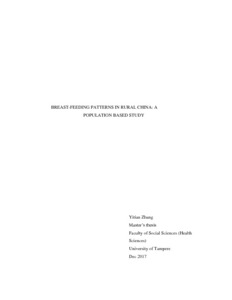Breast-feeding patterns in rural China : a population based study
Zhang, Yitian (2018)
Zhang, Yitian
2018
Master's Degree Programme in Public and Global Health
Yhteiskuntatieteiden tiedekunta - Faculty of Social Sciences
This publication is copyrighted. You may download, display and print it for Your own personal use. Commercial use is prohibited.
Hyväksymispäivämäärä
2018-01-08
Julkaisun pysyvä osoite on
https://urn.fi/URN:NBN:fi:uta-201801161057
https://urn.fi/URN:NBN:fi:uta-201801161057
Tiivistelmä
Background: Breast-feeding is considered to contribute infant’s health and development, protecting children from a variety of acute and chronic disorders as well as potential benefits for mothers. Breastfeeding has also potential to protect against childhood obesity; however, the evidence on the risk factors of breastfeeding remains unclear especially in the context of rural settings.
Objective: The objective of this study is to analyze the patterns and determinants of breastfeeding in three rural provinces of China.
Methods: A survey of new mothers in five rural counties among three province-level administrative divisions (Anhui, Shanxi, and Chongqing) in China was conducted in 2009. Data were collected by an interview after the interventions, including the demographic and pregnancy related characteristics of the mothers. Exclusive breastfeeding was measured by asking mothers the duration of the breastfeed only (in months) and categorized into two (0 to5 months and 6 to 11 months). Logistic regression was used to model the relationship of measured characteristics to the duration of exclusive breastfeeding. Odds ratios (ORs) and their 95% confidence intervals (CIs) were reported as the measure of the associations.
Results: The rate for exclusive breastfeeding over 6 months is relatively low. Only 3.9% of the babies received exclusive breastfeeding for more than 6 months in Chongqing. The key demographic determinants vary significantly among provinces. In Anhui, maternal age was found to be positively associated with exclusive breastfeeding duration, and in Shaanxi family income was found negatively associated with exclusive breastfeeding duration. Mothers with higher education level in this study were less likely to practice exclusive breastfeeding.
Conclusion: Exclusive breastfeeding over 6 months is relatively low in rural China, however the pattern largely varied by province. The key demographic determinants of exclusive breastfeeding include maternal age, education, occupation, as well as paternal occupation and family income.
Objective: The objective of this study is to analyze the patterns and determinants of breastfeeding in three rural provinces of China.
Methods: A survey of new mothers in five rural counties among three province-level administrative divisions (Anhui, Shanxi, and Chongqing) in China was conducted in 2009. Data were collected by an interview after the interventions, including the demographic and pregnancy related characteristics of the mothers. Exclusive breastfeeding was measured by asking mothers the duration of the breastfeed only (in months) and categorized into two (0 to5 months and 6 to 11 months). Logistic regression was used to model the relationship of measured characteristics to the duration of exclusive breastfeeding. Odds ratios (ORs) and their 95% confidence intervals (CIs) were reported as the measure of the associations.
Results: The rate for exclusive breastfeeding over 6 months is relatively low. Only 3.9% of the babies received exclusive breastfeeding for more than 6 months in Chongqing. The key demographic determinants vary significantly among provinces. In Anhui, maternal age was found to be positively associated with exclusive breastfeeding duration, and in Shaanxi family income was found negatively associated with exclusive breastfeeding duration. Mothers with higher education level in this study were less likely to practice exclusive breastfeeding.
Conclusion: Exclusive breastfeeding over 6 months is relatively low in rural China, however the pattern largely varied by province. The key demographic determinants of exclusive breastfeeding include maternal age, education, occupation, as well as paternal occupation and family income.
